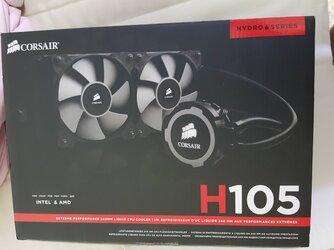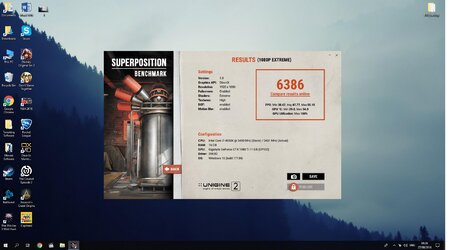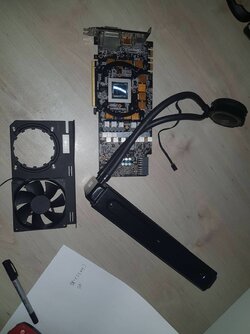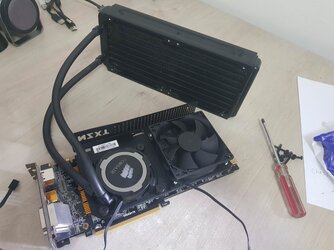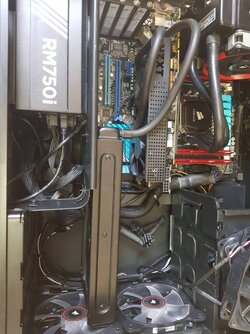- Thread Starter
- #21
Just to follow up on some things that were discussed here: I have found that lowering the pump speed to 67% will make the noise disappear. At this point it did have some effect on the temps (went up by 5 degrees on Valley) so I did not continue those tests. I also tried controlling it through speedfan. I was unable to do so. I don't know if it's because Speedfan is a complete mess or because the pump is a 3 pin (instead of 4 PWM). I was able to control PWM fans in the past.
Overall I am happy with how it worked. The way I mounted the GPU cooler forced me to adjust the airflow in my case. I think I've done the logical things. Previously I had a standard airflow configuration: Front intake, side intake, top exhaust. I've changed it as will be described by the photos:

This is how I mounted the GPU radiator. Ziptie mode FTW. The Push-pull fans are 2x Phobya NB-eLoop, and they're dead silent at ~1000 RPM. Right infront of them (red) are 2x 120mm Corsair fans running at 900RPM. They exhaust hot air out of the case through the front. The air absolutely feels hotter when GPU runs under load, which is a good thing in my book.


The case has two options: magnetic door closed or open. With the door closed there's still enough airflow from the sides to prevent the fans from choking. However, when doing sustained gaming I definetly feel the door getting warmer, so I leave it open most of the time. It doesn't make a big difference.

This is the CPU cooler, the RAM and the GPU beneath it. Nothing special about those, but why not post it anyway?

This is the side intake. I think it mostly contributes to the fresh air that goes into the VRM cooler of the GPU as well as the GPU radiator. The fan runs at 600 RPM and is very silent. However, there is a noise disadvantage with this side fan, it's not the fan itself that is noisy but rather the sound isolation from the components inside the case. Currently the pump rattling sound is the loudest thing in the case. It's not terrible but noticeable if you sit close to the PC on a dead silent room.

This is the top intake, it used to be an exhaust. The thing is that right now most of the side intake contributes to GPU radiator cooling from the side. Also top intake is good if you don't have heat constantly building up in your case. In my situation all of the components are isolated from each other and do not put a lot of heat into the case: PSU has its own fan and a shroud, GPU has its own radiator that exhausts from front-bottom side, CPU has its own radiator that exhausts from top-rear. So the goal with the top exhaust is to cool the MOBO's VRMs, RAM, and help bring some air through the CPU radiator. The fan is in a decent condition but it intakes at 800 RPM through a shroud and a mesh and generates a bit of noise because of it. Sadly it's a molex fan so nothing I can do other than replace the fan. I can probably live without it and save the PC from some dust but I like the way it looks.
If you have suggestions on changing the airflow, let me know!
Overall I am happy with how it worked. The way I mounted the GPU cooler forced me to adjust the airflow in my case. I think I've done the logical things. Previously I had a standard airflow configuration: Front intake, side intake, top exhaust. I've changed it as will be described by the photos:
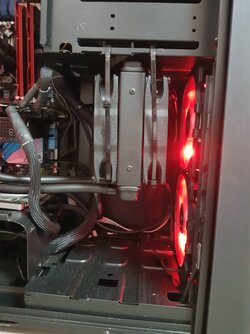
This is how I mounted the GPU radiator. Ziptie mode FTW. The Push-pull fans are 2x Phobya NB-eLoop, and they're dead silent at ~1000 RPM. Right infront of them (red) are 2x 120mm Corsair fans running at 900RPM. They exhaust hot air out of the case through the front. The air absolutely feels hotter when GPU runs under load, which is a good thing in my book.
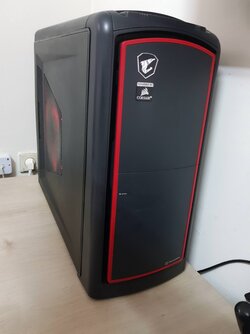
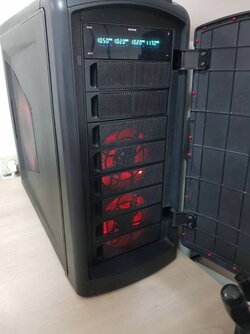
The case has two options: magnetic door closed or open. With the door closed there's still enough airflow from the sides to prevent the fans from choking. However, when doing sustained gaming I definetly feel the door getting warmer, so I leave it open most of the time. It doesn't make a big difference.
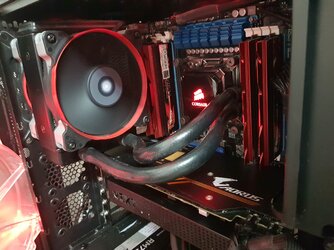
This is the CPU cooler, the RAM and the GPU beneath it. Nothing special about those, but why not post it anyway?
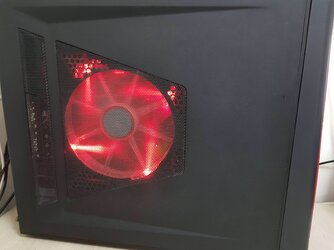
This is the side intake. I think it mostly contributes to the fresh air that goes into the VRM cooler of the GPU as well as the GPU radiator. The fan runs at 600 RPM and is very silent. However, there is a noise disadvantage with this side fan, it's not the fan itself that is noisy but rather the sound isolation from the components inside the case. Currently the pump rattling sound is the loudest thing in the case. It's not terrible but noticeable if you sit close to the PC on a dead silent room.
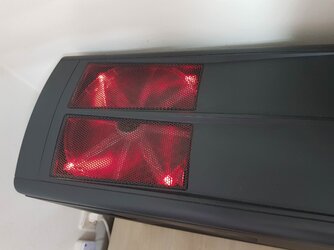
This is the top intake, it used to be an exhaust. The thing is that right now most of the side intake contributes to GPU radiator cooling from the side. Also top intake is good if you don't have heat constantly building up in your case. In my situation all of the components are isolated from each other and do not put a lot of heat into the case: PSU has its own fan and a shroud, GPU has its own radiator that exhausts from front-bottom side, CPU has its own radiator that exhausts from top-rear. So the goal with the top exhaust is to cool the MOBO's VRMs, RAM, and help bring some air through the CPU radiator. The fan is in a decent condition but it intakes at 800 RPM through a shroud and a mesh and generates a bit of noise because of it. Sadly it's a molex fan so nothing I can do other than replace the fan. I can probably live without it and save the PC from some dust but I like the way it looks.
If you have suggestions on changing the airflow, let me know!
Last edited:
